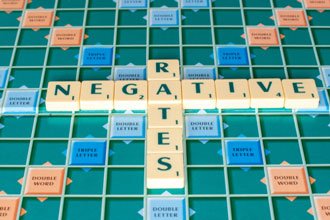
The United States is in a recession, even if we'll have to wait for official confirmation at the Bureau. With tens of millions of Americans out of work and many of these jobs not coming back, we're witnessing the most unprecedented economic event of our lifetimes.
I have said before that this is my generation's greatest economic challenge. And by the time it is over, it will fundamentally shift almost every industry in the United States. We will see great moves by the government to raise taxes and redistribute capital. But those matters are largely fiscal.
What about monetary policy?
Right now, the U.S. central bank has moved interest rates to zero. The April FOMC meeting was largely dedicated to preserving the Fed's benchmark rate to a range of 0% to 0.25%.
That said, there is a distinct possibility that interest rates could turn negative very soon in America.
I am not among the merry band of economists who embrace negative interest rates.
In fact, I believe they will be disastrous.
Listening to History
There are 16 Laws of Investing, according to the great Collaborative Fund.
Law No. 6 reads: The biggest risk is always whatever no one is talking about, because if no one's talking about it, they're not prepared for it.
I began talking about negative interest rates last fall, when the risks of a recession began swirling. At the time, most people dismissed the possibility of negative interest rates. Now, we're starting to hear some buzz again because of the Fed's recent meeting.
Last fall, I flew to Manhattan for an emergency meeting with two hedge fund managers and a colleague from Northwestern.
We focused on one thing: What would negative interest rates do to the financial markets?
The key takeaway: Financial models completely fall apart.
And I think they would cause one of the greatest shifts in financial theory in 120 years.
Every way that we value assets goes out the window when interest rates go negative.
CAPM, WACC, the Efficient Frontier, Sharpe Ratios... all these terms are used to show the performance of once asset against another. In the worst-case scenario, they become meaningless when U.S. rates go negative.
In most models, the 10-year Treasury Bond is supposed to be the ironclad asset, the risk-free asset, the one we compare all assets on performance and risk.
With negative rates, however, we can't properly assign value to anything.
Heck, we can't properly determine if pensions are funded in states.
We find that some assets with lots of cash flow suddenly have infinite possible returns because their cost of capital effectively becomes zero. It turns modern finance on its side - and no one seems to care right now.
Pundits are sitting on the beach watching tsunamis form instead of telling people to head for higher ground. Even in the best-case scenario, I want you to think about this.
In the "hypothetical" situation that the cost of capital becomes negative... it would require a rapid shift in thinking about asset valuation.
One that no one is prepared for because no one has seen it before.
Unstoppable: Our new Premium Stock Pick kept climbing while the rest of the market tanked. And as a leader in a new billion-dollar market, the gains are just getting started. Don't miss out - get this pick for free here...
In a "hypothetical" negative cost of capital situation, projects or investments with negative future cash flows indefinitely could be viewed as sensible investments as long as they cost less than borrowing money earned.
That means, when it comes to buying assets or investments, you are technically focusing on the idea that you want to lose as little money as possible instead of making as much money as possible.
Your investments can bleed cash... so long as you're losing less money in Investment A instead of Investment B.
This is an insane line of thinking that has never been tested except by the people who brag on the plane home from Las Vegas that they "only lost a few hundred bucks" playing blackjack.
This could easily become the new state of thinking if this goes sideways.
Why Negative Rates Aren't Working
Last year, former U.S. Federal Reserve Chair Alan Greenspan has suggested that negative rates wouldn't be a big deal.
Some people believe that negative interest rates would spur economic growth and help bolster the economy. These people also think it would help fight deflation.
But the economies of Europe and Japan have dabbled in negative interest rates for years now. In 2014, the European Central Bank (ECB) was the first to adopt a negative interest rate policy for deposit rates (-0.1%). It was supposed to only be temporary.
Today, the ECB deposit rate is -0.5%. That's a record low.
After turning to 0% rates in 1999, Japan's central bank went negative in 2016.
So how are these countries doing? Are they booming Meccas of economic prosperity?
Or are they - in reality - crumbling economies that must rely on more stimulus and central bank action?
The ECB has found no evidence that negative interest rates spur growth or drive companies to put more money into the economy.
I don't see how that will happen here, especially in an economy where incentives continue to be radically upended by government policy.
How Negative Rates Will Affect You
[mmpazkzone name="in-story" network="9794" site="307044" id="137008" type="4"]
Here are a few things that you need to know about investments and debt.
Savings Accounts
If interest rates go negative at the Fed, expect banks to follow. The banks are facing their own crisis with low interest rates and how it impacts their lending.
So, it will likely lead to you facing charges for using the bank. This isn't unprecedented. It happens all across Europe.
People want to have some security knowing that their money is in a vault.
Personally, I agree. There is no reason to put your money in the walls of your home. But you might want to consider CDs and other vehicles to get a higher rate...
Loans
Negative interest rates would likely lower mortgage rates even further.
In Finland, where rates are negative, house buyers could get a 20-year mortgage for 0% last year.
Personally, I think it's a really bad idea to get into house speculation.
If rates fall and you're looking to buy a home, make sure it's a place you want to live for the duration of the mortgage.
There is too much broader economic uncertainty, and I'm not going to advocate house flipping.
Credit Cards
Don't expect that you're going to get paid by your bank to use a credit card.
Interest rates and APR will move much higher, but it will pay to consider alternative finance lenders who might offer better terms.
Gold and Land
Right now, investors have poured U.S. bond prices higher, and we've seen the 10-year bond of multiple nations go negative.
This could easily happen in the United States as investors take faith ensuring that their money is tied up with the U.S. dollar, which remains the gold standard around the globe.
But the moment that rates go negative, it will incentivize the purchase of non-interest-bearing assets like gold and land. I advocate that people diversify 5% of their money with physical gold.
Personally, I am exploring agricultural land near my home in Florida as a potential long-term, illiquid investment.
How One Formula Can Hand You the Best of Both Worlds
Tom Gentile has uncovered a low-cost, high-potential opportunity that's practically tailor-made for today's market.
Anyone can get started with as little as $371... and in just a few weeks, you could walk away with a fortune.
It's all thanks to one special formula...
Follow Money Morning on Facebook and Twitter.
About the Author
Garrett Baldwin is a globally recognized research economist, financial writer, consultant, and political risk analyst with decades of trading experience and degrees in economics, cybersecurity, and business from Johns Hopkins, Purdue, Indiana University, and Northwestern.



